Physical Address
304 North Cardinal St.
Dorchester Center, MA 02124
Physical Address
304 North Cardinal St.
Dorchester Center, MA 02124
Leopard pitbulls trace their roots back to the late 1980s. At that time, breeders began mixing American Pitbull Terriers and Catahoula Leopard Dogs. This crossbreeding created a breed known for its unique look and loyalty.
The goal was to merge the strength and agility of pitbulls with the distinctive coat of the leopard dogs. These dogs quickly became sought after due to their powerful bodies and captivating coats.
This guide delves into the leopard pitbulls’ characteristics and care requirements. It aims to equip you with insights and advice, whether thinking of adopting one or already being an owner. We’ll discuss their traits, care needs, and well-being to ensure you’re a knowledgeable and thoughtful guardian.
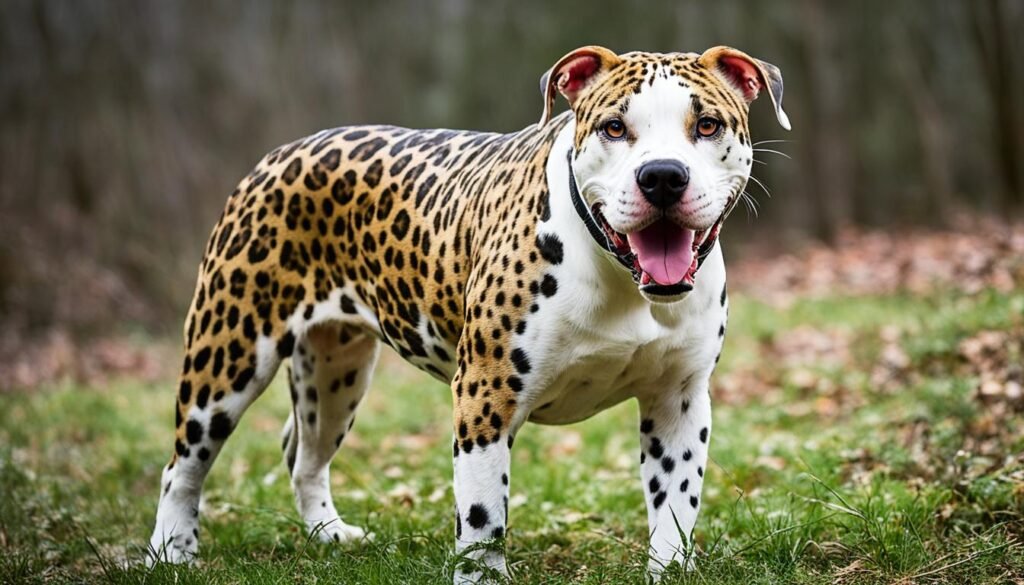
Known for being friendly and loyal, leopard pitbulls are excellent companions. Their temperament is a mix of genetic factors and individual traits. This makes each one unique in personality.
These dogs are full of energy and enjoy playtime. They’re ideal for active individuals or families with kids. Leopard pitbulls aim to please, which enhances their trainability. They excel in obedience and agility due to their intelligence and quick learning.
Leopard pitbulls show good compatibility with children. They become very attached to their families and are exceptionally loyal. Still, it’s important to remember that their temperaments may differ. Early socialization and training are key to shaping their behavior positively.
To choose a leopard pitbull, understanding their nature is crucial. With proper care and training, these dogs can be valuable, faithful members of the household.
Looking after a leopard pitbull means tackling their needs systematically. They require a balanced diet, exercise, and grooming. It’s key to give them a diet that meets their energetic lifestyle. Also, make sure they get daily exercise to stay happy and healthy. This also helps prevent any destructive behavior resulting from excess energy.
For their diet, pick a high-quality dog food that has everything they need. This includes protein, healthy fats, and essential vitamins and minerals. It’s wise to discuss diet plans with a vet for the best advice.

Regular exercise is a must for these lively dogs. Engaging in daily walks and playtimes is essential. Activities like fetch or even agility training are great for keeping them engaged.
Thanks to their short hair, grooming a leopard pitbull isn’t too demanding. Even so, a weekly brush to remove loose hair is beneficial. Keep their nails trimmed and their teeth clean for their total well-being.
A combination of a good diet, regular walks, and basic grooming will keep your leopard pitbull in top shape. Always remember to reach out to a vet for personalized advice.
Leopard pitbulls are usually in good health. But, they could face specific health issues. Frequent vet visits and good care help prevent and handle these problems. It’s key to pick a breeder who checks their dogs for genetic conditions. This cuts down on the risk for their puppies.
A nutritious diet, plenty of exercise, and cleanliness are also crucial for their health.
Common health problems in leopard pitbulls are as follows:
Leopard pitbulls require regular vet attention, vaccinations, and dental care. Staying proactive and health-focused is essential for a leopard pitbull’s happiness and longevity.
Training leopard pitbulls demands consistency, patience, and a positive approach. These dogs, being smart and eager to please, are highly trainable. Start their lessons early and mix them with other animals and people. This is vital for ensuring they are sociable and well-mannered.
Using positive reinforcement is a great tactic for teaching leopard pitbulls. Provide rewards like treats, praise, and play to boost good behavior. This approach makes training enjoyable and encourages the dog to keep up the good work.
Instilling obedience is a key step in leopard pitbull training. It ensures they heed commands and stay composed in all settings. Teaching them standard instructions, like “sit,” “stay,” and “come,” builds a solid training base. Be unwavering and patient, as mastery of these commands takes time.
It’s imperative to be clear and firm with your leopard pitbull during obedience lessons. Employing both voice commands and gestures enhances their grasp of what’s expected. A composed, authoritative manner while instructing reinforces your role as their guide.
Effective socialization is indispensable for leopard pitbulls. Introduce them to diverse settings, beings, and stimuli early on to foster stellar social prowess. This curtails the chances of fear or hostility towards new situations. Encouraging them to mingle with other dogs promotes peaceful interactions and curbs aggression.
Constant praises and rewards for good conduct are indispensable during training. Your leopard pitbull will respond well if you’re consistent, patient, and use positive reinforcement. This approach is key to molding them into respectful, affable partners.
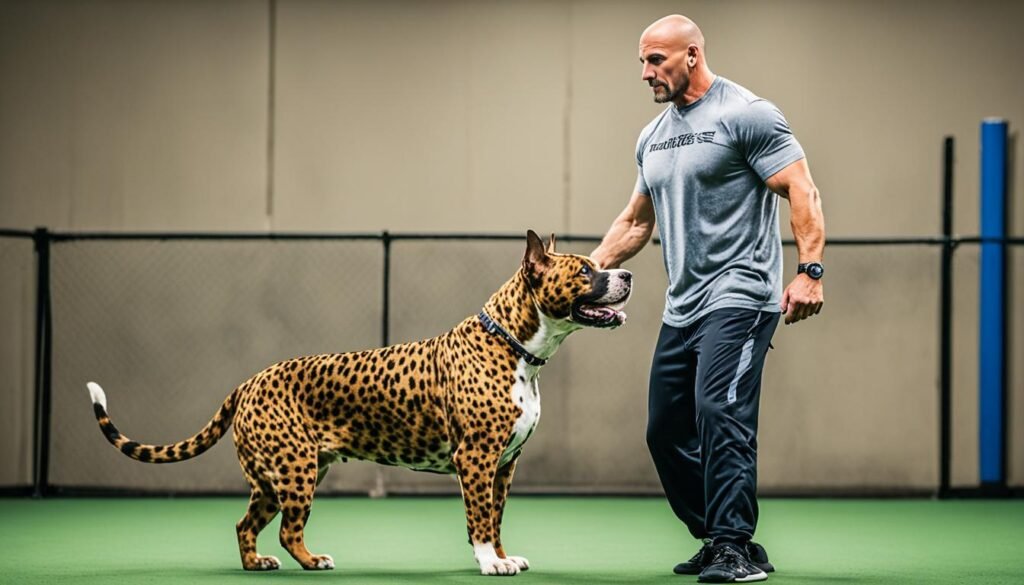
Leopard pitbulls are known for their friendly and loyal nature, perfect for families. They can create strong bonds with children if they receive proper training. It’s essential to oversee their interactions to keep everyone safe.
To ensure a peaceful coexistence, early socialization and training are crucial. Exposing leopard pitbulls to diverse situations from puppyhood enhances their social skills. This lays the groundwork for a respectful relationship with children.
Children should be taught the right way to engage with dogs. This includes approaches and playing, which reduces any risk of harm. Such lessons instill empathy and contribute to being good pet owners.
Leopard pitbulls can be wonderful additions to a family with the right care and attention. Ensuring they are well-trained and supervised provides a secure and affectionate atmosphere for both kids and pets.

| Pros | Cons |
|---|---|
| – Friendly and loyal nature | – Requires proper training and socialization |
| – Can form strong bonds with children | – Supervision is necessary |
| – Gentle and patient with children | – Teaching children appropriate interaction is essential |
| – Early socialization and training are key | – Requires responsible pet ownership |
Understanding the genetic foundation of leopard pitbulls is crucial for realizing their unique coat patterns. These patterns emerge from the breed’s genetic structure, initially a mix of American Pitbull Terriers and Catahoula Leopard Dogs.
The American Pitbull Terrier and Catahoula Leopard Dog each have their unique coat designs. A blend of these breeds gives leopard pitbulls a range of coat features, from spots to patches and brindle markings.
Genetic testing is a valuable tool for exploring the genetic components of leopard pitbulls and their varied coat patterns. It pinpoints the genes influencing these distinctive features.
Good breeders make genetic tests a standard part of their breeding dog care. This approach helps in safeguarding the well-being of future generations of leopard pitbulls by avoiding the inheritance of harmful genetic traits.

For a leopard pitbull, proper grooming is a must to maintain their coat’s beauty. Their short coats may seem low maintenance, but there are important steps to follow. These steps will keep their coat healthy and visually striking.
Regular brushing plays a key role in a leopard pitbull’s coat care. A soft-bristled brush should be used to remove loose hair and prevent tangles. This practice not only enhances shine but also evenly spreads natural oils. This benefits their coat’s health.
Bathing is required only when your leopard pitbull is dirty. Use a mild shampoo to avoid skin dryness. Too many baths can harm their coat by removing its natural oils. Ensure thorough rinsing to prevent skin irritation from shampoo residue.
Ears should be checked and cleaned routinely. A damp cloth or cotton ball can be used on the outer ear. Never insert items into the ear canal. This precaution helps avoid infestations and maintains ear health.
Trimming nails is vital for your dog’s comfort and mobility. Long nails can hinder their movement and posture. Keeping their nails appropriately short helps prevent walking issues and potential injuries.
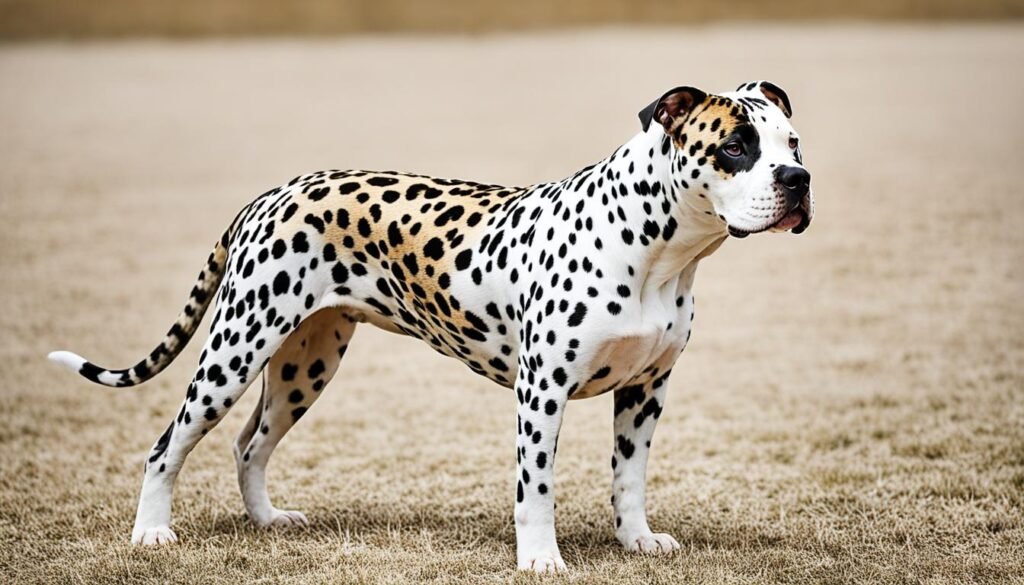
Protecting your leopard pitbull from sun exposure is also essential. Dogs, just like humans, can sunburn. Prolonged sun exposure can fade their coat pattern too. Apply pet-safe sunscreen on belly and ear areas before going out in the sun, preferably in cooler times of the day.
In conclusion, regular brushing, careful bathing, ear and nail care, and sun protection are vital for leopard pitbulls. These practices are crucial in ensuring your dog’s coat and overall health remain in top condition. Adhering to this routine will keep their coat shiny, healthy, and the envy of all.
Known for their boundless energy, leopard pitbulls thrive on regular exercise. Both their physical and mental health benefit significantly from an active lifestyle. This is pivotal for their overall well-being.
Daily walks present an ideal opportunity for exercise and mental engagement. They relish the chance to discover new scents and their environment. A durable leash and secure harness are crucial, ensuring their safety and your control.
Play sessions and activities like fetch or agility are also vital additions for leopard pitbulls. These not only serve to burn excess energy but also provide them with the mental challenge they crave. Adding puzzle toys and games to their repertoire further sharpens their mind and forestalls boredom.
Variety is key when it comes to nurturing a happy, healthy leopard pitbull. Exercise alternatives should span indoor and outdoor pursuits. Indoors, interactive toys and games can invigorate them, while outdoor adventures, like park visits or engaging in sports, offer further stimulation.
Training sessions count as both exercise and mental enrichment for leopard pitbulls. Their sharp minds delight in the challenges of obedience training and dog sports. These activities foster a stronger connection between you and your pet.
Without adequate physical activity, leopard pitbulls can veer towards boredom and destructive tendencies. A richly active lifestyle not only maintains their physical form but also nourishes their psychological health. Meeting their exercise requirements is fundamental for a content, well-rounded life.
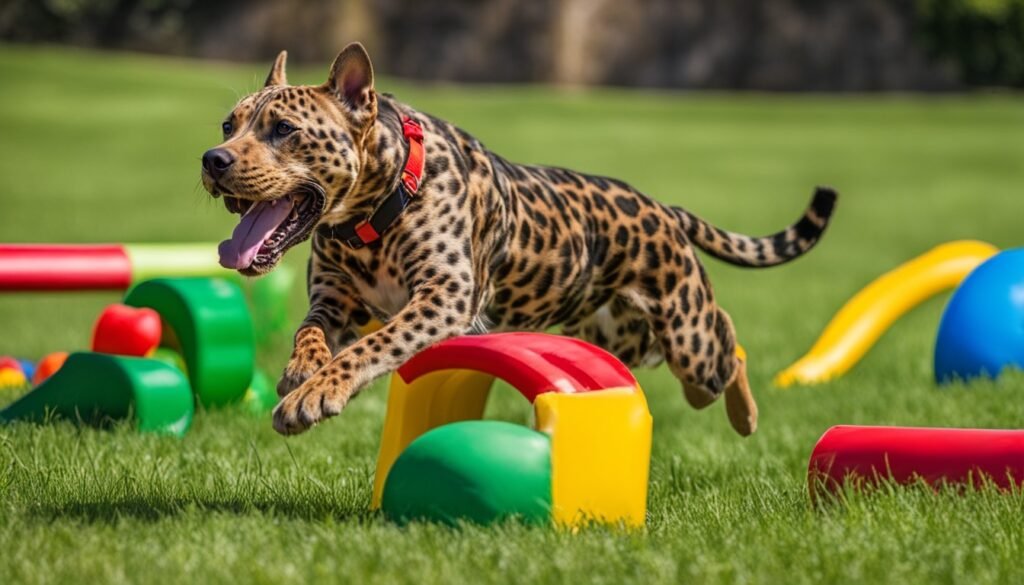
Leopard pitbulls require careful socialization to become well-behaved and welcoming in diverse settings. Early introduction to various locations, humans, creatures, noises, and new encounters is key. Enrolling them in puppy socialization classes and arranging supervised playdates with other canines is beneficial.
These interactions teach them proper conduct and assist in the cultivation of their social aptitude. Using positive reinforcement and rewarding experiences during these phases significantly influences their behavior. It minimizes the chances of them reacting with fear or hostility towards strangers, both human and animal alike.
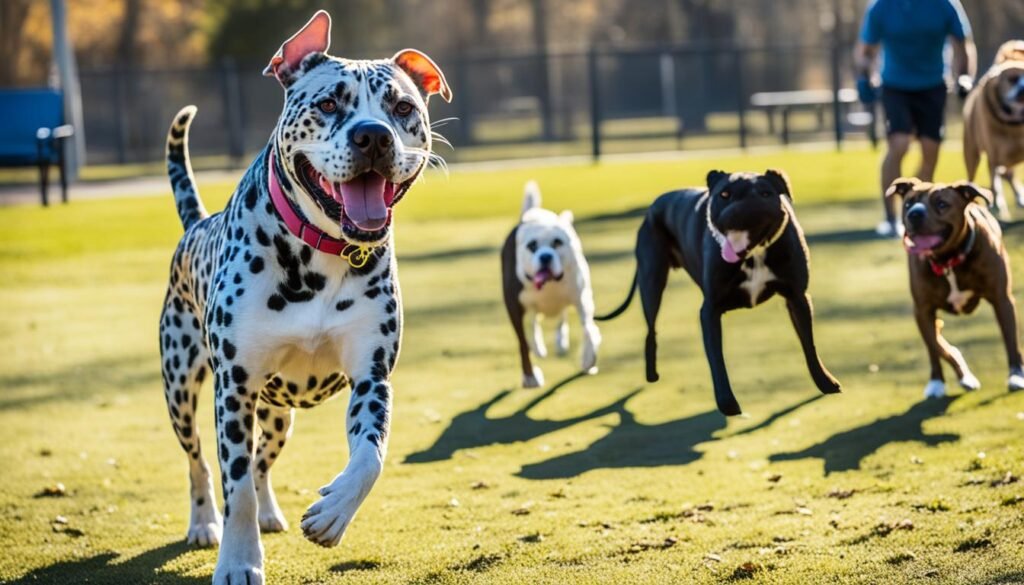
Leopard pitbulls are typically friendly and loyal, yet each one has a distinct personality. They, much like humans, show a range of social and personal traits. Some may be outgoing and friendly, others may be reserved and careful.
Their temperament is influenced by genetics from parent breeds, the American Pitbull Terrier and Catahoula Leopard Dog. This mix impacts their behavior.
Proper socialization is key in forming a leopard pitbull’s temperament. Positive exposure to people, animals, and settings benefits them greatly. This process helps avoid issues like fearfulness or aggression.
Training and past experiences can significantly mold a leopard pitbull’s nature. How they’ve been treated and trained influences their behaviors, making them unique.
Understanding your leopard pitbull’s specific character is vital. This understanding allows you to tailor their care and training to meet their needs. A strong basis of trust and mutual comprehension fosters a harmonious bond.
| Trait | Description |
|---|---|
| Friendly | Leopard pitbulls are generally friendly and sociable with people and other animals. |
| Loyal | They form strong bonds with their owners and are known for their loyalty. |
| Energetic | Leopard pitbulls have high energy levels and require regular exercise to remain happy and healthy. |
| Playful | They have a playful nature and enjoy engaging in interactive activities. |
| Intelligent | Leopard pitbulls are highly intelligent and can quickly learn new commands and tricks. |
While many leopard pitbulls share these traits, each is unique. Recognizing and respecting these differences is vital. This insight ensures you provide excellent care and training for your leopard pitbull pal.
Several notable leopard pitbulls have stood out over the years. Spike, a renowned leopard pitbull, excelled in obedience and agility. His dominance in various competitions made him a standout. Meanwhile, Luna, another remarkable leopard pitbull, served as a therapy dog. She brought solace to people in hospitals and nursing homes, showcasing the breed’s gentleness. These achievements highlight the intelligence, athleticism, and caring nature of leopard pitbulls.
| Leopard Pitbull | Achievements |
|---|---|
| Spike | Winner of multiple obedience and agility competitions |
| Luna | Became a therapy dog and provided comfort and support to individuals in hospitals and nursing homes |
The captivating coat of the leopard pitbull is intricately linked to its genetic heritage. A mix of American Pitbull Terriers and Catahoula Leopard Dogs, this blend birthed the striking pattern. This can manifest as spots, patches, or brindle fur.
Through genetic testing, we uncover the specific genes behind this unique coat trait. It paves the path for diligent breeding practices. Such efforts are crucial for the breed’s health, ensuring the absence of hereditary issues.
“Understanding the genetics behind the leopard pitbull coat pattern is essential for responsible breeding practices and maintaining the integrity of the breed.”
The exploration of leopard pitbull genetics offers insights beyond aesthetics. It delves into potential health vulnerabilities. Through strategic breeding, aiming to bolster positive genetic assets, breeders aim to enhance the breed.
This ongoing awareness of leopard pitbull genetics guides breeders’ choices. It aims to preserve the iconic coat pattern, a hallmark of the breed’s distinctive identity.
Grooming your leopard pitbull is crucial for a shiny, tangle-free coat. Even though their coat is short, it needs regular care. This ensures they always look their best.
Here are important steps to maintain your leopard pitbull’s coat:
These grooming practices will keep your leopard pitbull’s coat healthy and beautiful. They’ll not only look good but also feel good.
Leopard pitbulls are brimming with energy, needing regular exercise for their health and happiness. They do best with opportunities to burn their energy, making an active lifestyle vital. Activities like daily walks, playtime, and interactive games satisfy their exercise needs and keep them engrossed.
Regular activity with your leopard pitbull does more than keep them physically fit. It quells boredom and curbs destructive habits stemming from unused energy. Varying their exercises offers them mental challenges and prevents boredom. This can include outdoor adventures like hiking or swimming.
Their exercise should match their specific needs and capabilities. Some may need intense activities, while others fare better with shorter, more frequent exercises. Seeking advice from a vet or professional dog trainer can outline the best exercise plans for your leopard pitbull.
A lively routine is essential for a joyful, healthy leopard pitbull. Regular exercise caters not only to their physical requirements but also cements the bond between you and your pet.
In the late 1980s, breeders began crossing American Pitbull Terriers with Catahoula Leopard Dogs. This mix aimed to combine the pitbull’s athletic prowess with the leopard dog’s striking coat pattern.
Leopard pitbulls are known for their loyalty and friendliness. They possess high energy, intelligence, and a readiness to be trained. Typically, they are good with children and show affection to their families.
Bearing in mind that individual temperaments can differ, proper training and socialization are key.
Caring for a leopard pitbull involves a balanced diet, regular exercise, and thorough grooming. Given their high energy, daily exercise is a must. While their coat is low maintenance, they still need regular brushing and grooming.
Like most dogs, leopard pitbulls can face health issues including hip dysplasia, allergies, and skin conditions. Regular visits to the vet, along with proper care, are vital for preventing and managing these issues.
Effective leopard pitbull training requires consistent, patient, and positive methods. They are smart, eager to please, and thus easily trainable. Obedience training and socialization from an early age are critical for good behavior.
Yes, leopard pitbulls can be excellent family pets when they are well-trained and properly socialized at an early age. It is crucial for children to learn how to instill good behavior in dogs.
The unique coat pattern of leopard pitbulls stems from crossing American Pitbull Terriers and Catahoula Leopard Dogs. Both parent breeds contribute to this striking feature.
The minimal grooming needs of the leopard pitbull’s coat mean they are relatively easy to care for. Regular brushing and baths when necessary are advised. It’s also important to check ears for infections and keep nails trimmed. Protecting their coat from the sun is crucial to avoid sunburn and damage.
Due to their high energy levels, leopard pitbulls need plenty of exercise. Daily walks, playtime, and interactive activities are essential to keep them both physically and mentally healthy.
Proper socialization from a young age is key for leopard pitbulls. Exposure to various environments, people, and animals helps them develop into well-rounded dogs. Classes and controlled dog-to-dog interactions can be beneficial.
Although known for being friendly and loyal, some leopard pitbulls may show different social behaviors. Understanding and working with their unique personalities is essential for a strong and positive relationship.
Several leopard pitbulls have gained fame for their achievements. These include winning in canine obedience and agility, as well as serving as therapy dogs in healthcare settings.
The unique coat pattern of leopard pitbulls comes from crossing American Pitbull Terriers with Catahoula Leopard Dogs. Both breeds’ distinctive patterns blend in their offspring.
Due to their short coats, grooming leopard pitbulls is straightforward. Regular brushing and baths keep their coats healthy. Always check their ears and trim nails. Protect the coat from sun damage to prevent injuries.
Leopard pitbulls have high energy and need daily physical and mental engagement. Regular walks, playful activities, and training sessions keep them happy and healthy.